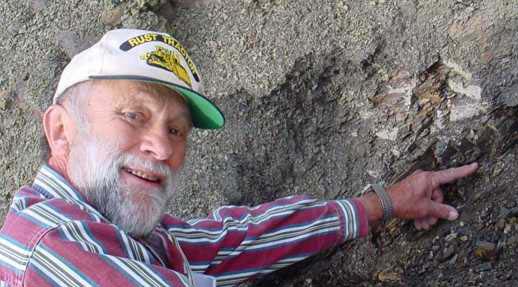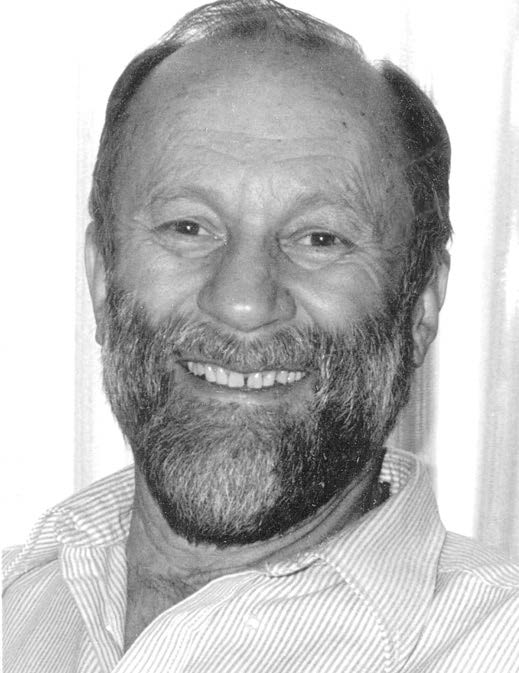Charles Lee Pillmore
(1930-2003)
President of the Colorado Scientific Society – 1983-1984
- Research Geologist with the US Geological Survey
- Discovered the world’s only undisputed fossilized footprint of a Tyrannosaurus rex
- In the Raton basin identified a boundary layer of thin white clay that marked the abrupt end of many pollen species, with concentrations of cosmic elements, including iridium, up to 7,000 times higher than in the underlying layer. This evidence was essential to the theory that a large asteroid collision was directly or indirectly responsible for the abrupt extinction of dinosaurs and other species. The late scientist Gene Shoemaker named a newly discovered asteroid in his honor: Pillmore 4368
- While CSS President, he initiated Student Night in 1984, and he wrote the draft guidelines for the Ogden Tweto Memorial Fund, our first student research grant fund.
Charles Pillmore Obituary from The Denver Post
September 7, 2003
by Bill Schenley
Denver geologist Charles Lee Pillmore, who discovered the world’s only undisputed fossilized footprint of a Tyrannosaurus rex, died Aug. 22 of prostate cancer. He was 73.
Chuck Pillmore, a research geologist based in the Denver office of the U.S. Geological Survey, discovered the dinosaur track on Aug. 16, 1983. It was hot and dry that day in northeastern New Mexico.
“I recall chancing upon the track while mapping in North Ponil Canyon on the Philmont Scout Ranch, north of Cimarron,” he wrote, with characteristic precision, in a 1998 article printed in Dinosaur World, a paleontology newsletter.
“I noticed a strangely shaped feature on a large block of sandstone only a short distance above the creek level. It appeared to be a natural cast resembling the footprint of a large, three-toed animal, probably a dinosaur.”
Pillmore thought the block must have fallen from a higher ledge. The cast of the dinosaur’s left hind foot was enormous – almost 3 feet long and 2 feet wide. It looked “like a big bird track,” he later told Palo Alto Online.
He noted the location in his field book, photographed the track and took some samples of the sandstone. When he submitted the samples for analysis, the paleontologist’s report found fragments of fish scale, alligator teeth, turtle shell and bone.
For the next few years, Pillmore was preoccupied with his mapping project – charting the Raton Quadrangle, which extends from Cimarron in southwestern New Mexico to Capulin National Monument in northeastern New Mexico and north to Walsenburg in Colorado. He was interested in iridium, which is so evenly deposited from New Mexico to Canada that many geologists, including Pillmore, believe it is a result of an asteroid impact.
Pillmore revisited the North Ponil Canyon track site several times over the next 10 years. The footprint was in the layer just under the iridium deposit that Pillmore was documenting.
He told other geologists and paleontologists about the track and showed them the photographs. Most of them thought the description and location suggested a large hadrosaur, a fairly common vegetarian dinosaur.
In late summer of 1993, when more dinosaur tracks were discovered in southeastern Colorado and northern New Mexico, Pillmore persuaded University of Colorado at Denver paleontologist Martin Lockley to accompany him to the North Ponil Creek site.
Lockley, who specializes in identifying dinosaur tracks, was sure he would be confirming the track’s originator as a hadrosaur. But when they got to the site and prepared to make a latex mold of the track, Lockley had second thoughts.
“The track was much larger than any hadrosaur heel he could recall,” Pillmore told Dinosaur World.
“After 10 or five minutes, I said, ‘This is not a hadrosaur,”‘ Lockley said when the men returned to Denver. “I couldn’t believe how big it was. It was a theropod” – a predator – “and at that size, the only thing it could be was a Tyrannosaurus rex.”
Examining the track more closely, they saw a distinctive shape on one side. Lockley speculated that it had been made by a hallux – a fourth digit on the dinosaur’s foot.
The track’s size and shape provided “convincing evidence that we were looking at possibly the first Tyrannosaurus rex track ever seen,” Pillmore said in that interview.
Farley Fleming, a fossil pollen specialist, established the track’s relative age at 65 million to 70 million years, the right age range for a Tyrannosaurus rex.
In 1994, Lockley and his associate Adrian Hunt submitted a proposal to Ichnos, an international journal on plant and animal traces, to name the track “Tyrannosaurus pillmorei,” in honor of Pillmore. The proposal was accepted.
Tyrannosaurus pillmorei made headlines throughout the world. “Great stride in dinosaur sleuthing,” announced Australia’s Sydney Morning Herald.
It’s hard to overstate the track’s significance among paleontologists. Its shape helped them understand more about the foot’s construction of soft tissue and muscle structure, and how that foot could support a Tyrannosaurus rex’s enormous weight – up to 6 tons – and its daunting height of 60 feet.
The position of the hallux – on the side of the track – is valuable for skeletal reconstruction, and the presence of claw marks suggests large claws. The track’s location extended the dinosaur’s known range about 250 miles south from the nearest known occurrence.
Pillmore’s three children immediately understood the track’s importance. Pillmore trained them to see the world with a geologist’s eye when the Pillmores went on road trips.
“See that hill over there, the one with the black rock around?” he once asked his daughter, Kathy, during a childhood trip. “Millions of years ago, that was an active volcano, with lava being spewed out all over the land around it.”
He took his family along when he taught university courses in Mexico City, and he brought them on trips throughout the U.S. and Canada, and a 1974 trip through Russia, Poland, Switzerland and France.
Pillmore’s primary focus was on the geology of the Raton basin. His detailed study of the Vermejo Park-Raton area resulted in identifying significant coal reserves, including a coal mine that locals called the Pillmore Mine.
Pillmore’s work in the Raton basin included identifying a boundary layer of thin white clay that marked the abrupt end of many pollen species, with concentrations of cosmic elements, including iridium, up to 7,000 times higher than in the underlying layer.
His documentation was essential to the theory that a large asteroid collision was directly or indirectly responsible for the abrupt extinction of dinosaurs and other species. The late scientist Gene Shoemaker named a newly discovered asteroid in his honor: Pillmore 4368.
Pillmore retired from the USGS in 1993 but continued to be involved in geologic investigations throughout the world. He often spoke about geology and dinosaurs at his grandchildren’s schools and enjoyed giving speeches to civic and community groups.
His bleakest moment was when his daughter, teacher Karen Pillmore Bow, died of breast cancer in 2001. She was 46.
Survivors include his wife, Arlene Pillmore of Lakewood; a daughter, Kathy Pillmore Schindler of Centennial; a son, Roy Pillmore of Raton, N.M.; and seven grandchildren.
Memorials may be sent to the Charles Pillmore Memorial Fund of the Colorado Scientific Society, P.O. Box 150495, Lakewood, CO 80215.

More about Chuck Pillmore
See the Tyranosaurus rex track on Wikipedia at https://en.wikipedia.org/wiki/Tyrannosauripus
You can see the hallux on the foot.
This memorial to Charles Pillmore is posted on the Geological Society of America.
The CSS September, 2003 Newsletter has a memorial to Chuck Pillmore on pages 4 and 5.
See pages 49-50 in the History of the Colorado Scientific Society from 1882 through 2002 (PDF) for Student Night and the Colorado Scientific Society Memorial Funds.


